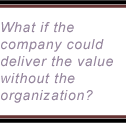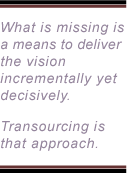—o—o—o—o—o
—o—o—o—o—o
Inquire about a
speaking
engagement


Vision/The Transformation Imperative
The Challenge and the OpportunityThese developments leave 20th century industrial companies in an awkward situation. Now, they need to excel at collaborative innovation—historically a weak point—to capture and hold customers' attention. In the Knowledge Economy, innovation will replace efficiency as the primary driver of value creation. Competitors that can engage rapidly shifting customer desires will dominate. To succeed, incumbents must quickly become more adaptive and collaborative with external partners. Moreover, they must transform themselves while they continue to operate at increasing levels of performance. Transourcing™ was designed to meet this challenge.
Transformation, from Self-contained Company to Networked Global OrganizationTransourcing™ denotes a future state in which the organization is defined by its adaptive network of business entities. Its networked structure enables it to put customer needs before the needs of the organization. Today, most corporate "organizations" are defined by their positions within their enterprises' organizational structures, and their actions are defined by their performance within the departmental context. Thanks to "reengineering" pioneers, executives began to appreciate the relevance of the business process orientation in the 1980s, but very few organizations have truly been transformed. The organization has been the required mechanism to deliver value to the customer, but it adds little value to the customer today (its services do). E-Business, the application of open standards-based Internet technologies and processes throughout enterprises of all sizes, has provided an opportunity to change all this. Because executives increasingly have granular, real-time information about business processes, they can change the model: in effect, the degree of information available renders the "organization" far less relevant today, and the stage is set to move the customer-serving business process in the forefront. What does this mean? First, execute the process in the way that is most advantageous to the customer, based on the nature of the customer's request and the enterprise's ability to fulfill it at that moment in time. Real-time, granular information can begin to enable executives to understand that the context around requests (for products or services) and their fulfillment is in constant flux. Previously, executives did not have the information or visibility. But "organizations," which were required prior to the e-business era to manage inflexible actions that coordinated complex inputs to produce and deliver products/services are no longer required. Because each part of a business process increasingly can self-report its status, it can be reconfigured on the fly as needed. In other words, processes will increasingly self-organize. Self-organizationSelf-organization is a future state that already exists in pockets today, and it will be more true every month that passes. But executives have a serious legacy problem: organizations have provided the structure and coordination to marshall tremendous resources to produce vast amounts of product very efficiently. If they want to dismantle them in favor of the business process, how can this be accomplished? How does one change a tire while the car is still rolling? It is well established that organizations struggle with "adaptiveness." Why? Their method of making order out of chaos has been scale and its inflexibility. They have "tightly coupled" (inflexible) processes, which were required due to the massive process dependencies within the enterprise. The future state calls for enterprise organizational structures to devolve into "business components" that fulfill service requests from each other using standardized communications (business services). Such business components will organize themselves around service requests. Of course this idea is by no means new; however, I.T. maturation, business process digitization and the rapidly developing, robust outsourcing provider market make process-focused transformation actionable today. What is missing is an approach to deliver the vision incrementally yet decisively. Transourcing™ is that approach. Transourcing™ as Transformation Enabler
The Transourcing™ Enterprise Roadmap regards the future state and poses the question, "In a practical sense, how do we get there from here? What does the process look like, and how can we use outsourcing to deliver incremental value while we build adaptiveness?" Executives who can answer this question will create tremendous competitive advantage and change their industries. Creating the process-focused and network-structured organization will require a major shift to collaboration as a primary operating principle. Because a key element of transformation is making the organization smaller by "out"sourcing, the key premise behind outsourcing's traditional rationale is a poignant tactical tool; moreover, collaboration for its own sake is central to the long-term, strategic value proposition. Innovation will be critical to survival in the Knowledge Economy, and enterprises will need to fundamentally change how they create value for customers. Products and services that are created and delivered via an industrial process commoditize quickly because they are difficult to differentiate. Innovation will be required to create and deliver rich customer experience, which will increasingly be the explicit focus for creating value for customers. Enterprises will have to shift their emphasis from efficiency to relevant novelty. The ability to source external specialists on demand will be critical to building a sustainable ability to innovate because innovation always entails discontinuous change, and groupthink does not produce innovation.
|

 The 21st century's emerging Knowledge Economy is very different from its 19th and 20th century predecessor, the Industrial Economy. Today, most of the world's global commercial and governmental organizations increasingly find themselves confronted by the Knowledge Economy's new success factors, which are often contrary to the Industrial Economy's. Compounding the challenge, most competitors have had similar structures and limitations to incumbents', which gave everyone more time to adapt to change; however, new Knowledge Economy competitors often do not have the same structures and limitations. Technology and globalization are changing the rules of engagement.
The 21st century's emerging Knowledge Economy is very different from its 19th and 20th century predecessor, the Industrial Economy. Today, most of the world's global commercial and governmental organizations increasingly find themselves confronted by the Knowledge Economy's new success factors, which are often contrary to the Industrial Economy's. Compounding the challenge, most competitors have had similar structures and limitations to incumbents', which gave everyone more time to adapt to change; however, new Knowledge Economy competitors often do not have the same structures and limitations. Technology and globalization are changing the rules of engagement. What if the company could deliver the services without the organization? The industrial organization is large, complex and expensive, and maintaining its optimal function too often requires the enterprise to focus on itself at the expense of the customer. Transourcing™ proposes to separate the organizational structure from the services it delivers—enabling the company to transform how it delivers value to customers.
What if the company could deliver the services without the organization? The industrial organization is large, complex and expensive, and maintaining its optimal function too often requires the enterprise to focus on itself at the expense of the customer. Transourcing™ proposes to separate the organizational structure from the services it delivers—enabling the company to transform how it delivers value to customers.  Transourcing™ is a pragmatic enabler of organizational transformation. "Outsourcing" is a current state means to increase collaboration with process specialists so that the enterprise-via-its-partner (the extended enterprise) executes those processes more artfully and efficiently. Transourcing™ is an initiative that we can undertake now to save money, enjoy higher performance and make the organization smaller and more innovative through collaboration. It develops a sustainable innovation capability by practicing outsourcing to build collaboration processes that are subsequently reused to source innovation partners. It simultaneously provides near-term, tactical benefits and long-term, strategic benefits.
Transourcing™ is a pragmatic enabler of organizational transformation. "Outsourcing" is a current state means to increase collaboration with process specialists so that the enterprise-via-its-partner (the extended enterprise) executes those processes more artfully and efficiently. Transourcing™ is an initiative that we can undertake now to save money, enjoy higher performance and make the organization smaller and more innovative through collaboration. It develops a sustainable innovation capability by practicing outsourcing to build collaboration processes that are subsequently reused to source innovation partners. It simultaneously provides near-term, tactical benefits and long-term, strategic benefits.